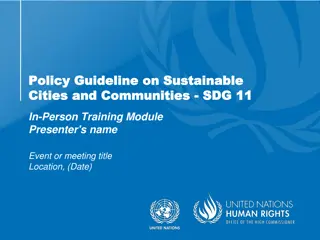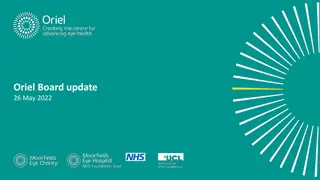Building Resilient and Inclusive Cities Through the Safe Hospitals Initiative
The Safe Hospitals Initiative, led by Dr. Ciro Ugarte, emphasizes the importance of accessibility, inclusion, and resilience in city planning. It advocates for involving persons with disabilities in the planning process, improving communication for first responders, and ensuring basic needs in accessible shelters. The initiative focuses on risk reduction, early rehabilitation, mental health support, and violence prevention. It outlines the key elements of safe health services, such as security, autonomy, and comfort. The challenge of hospital safety in disaster-prone areas in Latin America and the Caribbean is addressed, with a call to action for better preparedness, response, and recovery strategies.
Download Presentation

Please find below an Image/Link to download the presentation.
The content on the website is provided AS IS for your information and personal use only. It may not be sold, licensed, or shared on other websites without obtaining consent from the author.If you encounter any issues during the download, it is possible that the publisher has removed the file from their server.
You are allowed to download the files provided on this website for personal or commercial use, subject to the condition that they are used lawfully. All files are the property of their respective owners.
The content on the website is provided AS IS for your information and personal use only. It may not be sold, licensed, or shared on other websites without obtaining consent from the author.
E N D
Presentation Transcript
Accessibility, inclusion and resilience-building of cities The Safe Hospitals Initiative Dr. Ciro Ugarte Director Emergency Preparedness and Disaster Relief
Make persons with disabilities visible Involve them in the planning process Risk Reduction Their needs must be considered Improve communication and information First responders have to be trained Guarantee basic needs Accessible shelters Early Rehabilitation, mental health, prevention of violence Preparedness & Response Rebuilt better and rebuilt always with them Recovery
ACCESIBILITY BRIDGE ASSESMENT RESEARCH INCLUSION ICT s METODOLOGIES LEGAL FRAMEWORKS NATIONAL NORMATIVE Adapted from El puente de la accesibilidad , SETEDIS 2015
ACCESIBILITY: A KEY ELEMENT OF SAFE HEALTH SERVICES PRIORIZATION OF INTERVENCIONS SECURITY AUTONOMY CONFORT DALCO CRITERIA
The problem More than 67% of the nearly 18,000 hospitals in Latin America and the Caribbean are located in areas at higher risk of disasters. Hospitals are a huge investment and represent close to 70% of the Ministries of Health budget. In the Americas, 61% of the impact on health facilities is caused by earthquakes; 17% by hurricanes; 14% by floods and 8% by health emergencies, causing massive impact in health care and enormous economic loss for the health sector.
From Theory to Practice in the Health Sector In theory, the health sector should be able to ensure that all health facilities are safe from disasters. In practice, it is necessary to begin increasing the safety of those health services that are located in high risk areas and that provide essential life-saving health care services. 7
Safe Hospital Is a health facility whose services remain accessible and functioning, at its maximum capacity and in the same facility immediately after a large-scale disaster or emergency. The key issue is in the level of protection!
Levels of Protection I. Life Protection (patients, health personnel and visitors) II. Investment Protection (equipment, furnishings and utility services) III. Operational Protection (maintain or improve or improve the facility s capacity to function).
New Facilities There is now a clear mandate and commitment to improve the design of new facilities. Disaster resilience is best and most economically done at the earliest stage of the planning Additional cost is modest (around 4%) but rising when risk reduction measures are considered later in the process
Existing Facilities Retrofitting all vulnerable facilities is unrealistic in most countries The cost of retrofitting can be as high as 40% of the replacement value
Hospital design Designed to meet the needs of all hospital users, that is patients, visitors, health care workers and others, regardless of their age or size and those who have any particular physical, sensory, mental health or intellectual ability or disability. Compliance with building codes and regulations, health and safety regulations, and equality legislation.
Access to hospitals An easy or moderate ramp or slope at the entrance and manual or automatic doors, and Doors with a clear door width of at least 75cm throughout Walkways typically provide an internal access route within a building or a link connecting one or more adjacent buildings in a large complex hospital, such as a hospital.
Internal circulation in hospitals Walkways provide an internal access route within a building or a link connecting one or more adjacent buildings in large hospitals. Floor finishes incorporate a colored line to lead people between different services of the hospital. In large hospitals, a floor plan or map should be displayed to enable people to orientate themselves
Safety of the elevator system While elevators should not be used during an internal or external emergency or disaster, they play an important role after the event. Evaluators should take into account that elevators are the main means of transport for many patients, the elderly and persons with disabilities. Lifts in hospitals are required to accommodate beds, trolleys, and other equipment.
Other considerations Queuing announcement systems: the audible signal should be a voice announcement, adjustable between 35 dB(A) and 65 dB(A) to suit the site conditions. Properly designed reception and waiting areas are essential in hospitals to allow persons to wait, sometimes for long periods. Communication via markers such as flags can be effective, particularly for people with hearing difficulties.
Corrective measures Maintaining and improving health and safety of hospital occupants is a paramount objective. All emergency exit routes must be free obstructing items and ensure that handrails, stairs, steps and ramps are in good safety condition.
Final reflection The World Health Organization (WHO) Health Impact Assessment, emphasizes the importance of qualitative information, including the opinions, experience and expectation of those likely to be most directly affected. This also applies to the planning, design, building, operation, and safety interventions in health facilities incorporating accessibility, inclusion and resilience-building of hospitals as part of the New Urban Agenda
Accessibility, inclusion and resilience-building of cities The Safe Hospitals Initiative Dr. Ciro Ugarte Director Emergency Preparedness and Disaster Relief























